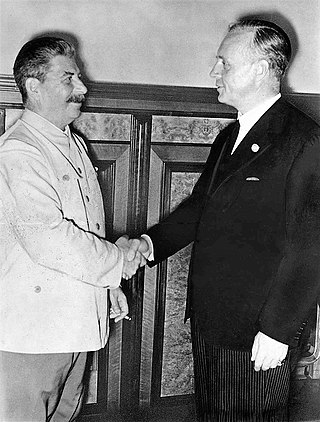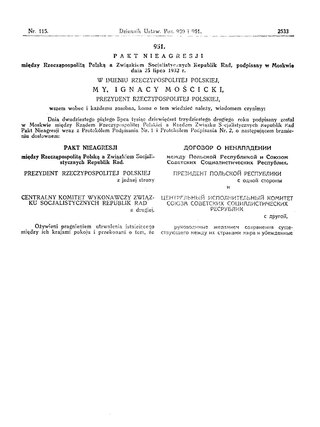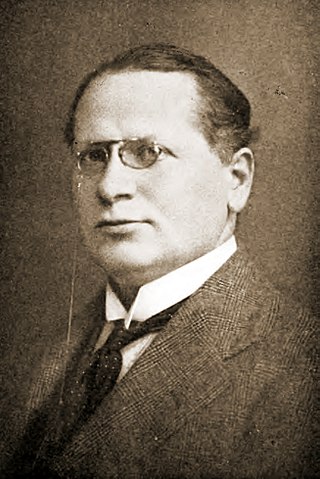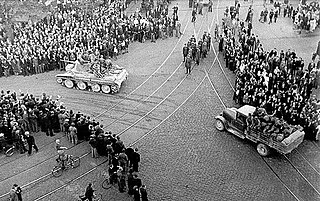
The Molotov–Ribbentrop Pact, officially the Treaty of Non-Aggression between Germany and the Union of Soviet Socialist Republics, was a non-aggression pact between Nazi Germany and the Soviet Union with a secret protocol that partitioned Central and Eastern Europe between them. The pact was signed in Moscow on 23 August 1939 by German Foreign Minister Joachim von Ribbentrop and Soviet Foreign Minister Vyacheslav Molotov. Unofficially, it has also been referred to as the Hitler–Stalin Pact, Nazi–Soviet Pact, or Nazi–Soviet Alliance.

German–Soviet Union relations date to the aftermath of the First World War. The Treaty of Brest-Litovsk, dictated by Germany ended hostilities between Russia and Germany; it was signed on March 3, 1918. A few months later, the German ambassador to Moscow, Wilhelm von Mirbach, was shot dead by Russian Left Socialist-Revolutionaries in an attempt to incite a new war between Russia and Germany. The entire Soviet embassy under Adolph Joffe was deported from Germany on November 6, 1918, for their active support of the German Revolution. Karl Radek also illegally supported communist subversive activities in Weimar Germany in 1919.

The Baltic Entente was based on Treaty of Good-Understanding and Co-operation signed between Lithuania, Latvia, and Estonia on 12 September 1934 in Geneva. The main objective of the agreement was joint action in foreign policy. It also included commitments to support one another politically and to give diplomatic support in international communication. The endeavour was ultimately unsuccessful, as the combined strength of the three nations and their statements of neutrality were insubstantial in the face of the massive armies of Poland, Germany and the Soviet Union.

The Soviet–Polish Non-Aggression Pact was a non-aggression pact signed in 1932 by representatives of Poland and the Soviet Union. The pact was unilaterally broken by the Soviet Union on September 17, 1939, during the Soviet invasion of Poland.

The Litvinov Protocol is the common name of an international peace treaty concluded in Moscow on February 9, 1929. Named after the chief Soviet diplomat moving the negotiations forward, Maxim Litvinov, the treaty provided for immediate implementation of the Kellogg-Briand Pact by its signatories, thereby formally renouncing war as a part of national foreign policy.

The three Baltic countries, or the Baltic states – Estonia, Latvia, and Lithuania – are held to have continued as legal entities under international law while under the Soviet occupation from 1940 to 1991, as well as during the German occupation in 1941–1944/1945. The prevailing opinion accepts the Baltic thesis of illegal occupation and the actions of the USSR are regarded as contrary to international law in general and to the bilateral treaties between the USSR and the three Baltic countries in particular.

The Soviet occupation of Latvia in 1940 refers to the military occupation of the Republic of Latvia by the Soviet Union under the provisions of the 1939 Molotov–Ribbentrop Pact with Nazi Germany and its Secret Additional Protocol signed in August 1939. The occupation took place according to the European Court of Human Rights, the Government of Latvia, the United States Department of State, and the European Union. In 1989, the USSR also condemned the 1939 secret protocol between Nazi Germany and herself that had led to the invasion and occupation of the three Baltic countries, including Latvia.
Soviet–Lithuanian Non-Aggression Pact was a non-aggression pact, signed between the Soviet Union and Lithuania on September 28, 1926. The pact confirmed all basic provisions of the Soviet–Lithuanian Peace Treaty of 1920. The Soviet Union continued to recognize Vilnius and Vilnius Region to Lithuania, despite the fact that the territories were under Polish control since the Żeligowski's Mutiny in 1920. It also recognized Lithuania's interests in the Klaipėda Region. In exchange Lithuania agreed not to join any alliances directed against the Soviet Union, which meant international isolation at the time when Soviet Union was not a member of the League of Nations. Ratifications were exchanged in Kaunas on November 9, 1926, and the pact became effective on the same day. The pact was registered in League of Nations Treaty Series on March 4, 1927.

The German–Estonian Non-Aggression Pact was signed in Berlin on June 7, 1939, by Estonian and German Foreign Ministers Karl Selter and Joachim von Ribbentrop. The German–Latvian Non-Aggression Pact was also signed on the same day. Ratifications of the German-Estonian Pact were exchanged in Berlin on July 24, 1939, and it became effective the same day. It was registered in League of Nations Treaty Series on August 12, 1939. The pact was intended for a period of ten years.

The German–Latvian Non-Aggression Pact was signed in Berlin on June 7, 1939.

Relevant events began regarding the Baltic states and the Soviet Union when, following Bolshevist Russia's conflict with the Baltic states—Lithuania, Latvia and Estonia—several peace treaties were signed with Russia and its successor, the Soviet Union. In the late 1920s and early 1930s, the Soviet Union and all three Baltic States further signed non-aggression treaties. The Soviet Union also confirmed that it would adhere to the Kellogg–Briand Pact with regard to its neighbors, including Estonia and Latvia, and entered into a convention defining "aggression" that included all three Baltic countries.
The timeline of the occupation of the Baltic states lists key events in the military occupation of the three countries – Estonia, Latvia and Lithuania – by the Soviet Union and by Nazi Germany during World War II.
The background of the Winter War covers the period before the outbreak of the Winter War between Finland and the Soviet Union (1939–1940), which stretches from the Finnish Declaration of Independence in 1917 to the Soviet-Finnish negotiations in 1938–1939.
The timeline of the Winter War is a chronology of events leading up to, culminating in, and resulting from the Winter War. The war began when the Soviet Union attacked Finland on 30 November 1939 and it ended 13 March 1940.

Aarno Armas Sakari Yrjö-Koskinen was a Finnish politician, Envoy and freiherr. He graduated as jurist and received the title varatuomari in 1915.
The timeline of the Molotov–Ribbentrop Pact is a chronology of events, including Molotov–Ribbentrop Pact negotiations, leading up to, culminating in, and resulting from the Molotov–Ribbentrop Pact. The Treaty of Non-aggression between Nazi Germany and the Soviet Union was signed in the early hours of 24 August 1939, but was dated 23 August.

The background of the occupation of the Baltic states covers the period before the first Soviet occupation on 14 June 1940, stretching from independence in 1918 to the Soviet ultimatums in 1939–1940. Lithuania, Latvia, and Estonia gained independence in the aftermath of the Russian revolutions of 1917 and the German occupation which in the Baltic countries lasted until the end of World War I in November 1918. All three countries signed non-aggression treaties with the Soviet Union in the 1920s and 1930s. Despite the treaties, in the aftermath of the 1939 German–Soviet pact, Estonia, Latvia and Lithuania were occupied, and thereafter forcibly incorporated into the Soviet Union, in 1940.
The Soviet–Estonian Non-Aggression Pact was a non-aggression pact, signed between the Soviet Union and Estonia on May 4, 1932. It was ratified by Estonia on 29 July 1932 and the Soviet Union 5 August 1932, and entered into force on 18 August 1932 for the period of 3 years. The pact provided the opportunity to be renounced 6 months before expiration or by either Estonia or USSR at any time without notice in the event of an act of aggression by the other party against any third state. If not renounced the pact was to be prolonged each two years for indetermined period. The pact was prolonged until 31 December 1945 on 4 April 1934 and was again reaffirmed on 28 September 1939.
The Eastern Pact was a proposed mutual-aid treaty, intended to bring France, the Soviet Union, Czechoslovakia, Poland, Finland, Estonia, Latvia, and Lithuania together in opposition to Nazi Germany.

The Soviet–French Non–Aggression Pact was a Non–Aggression Pact concluded on November 29, 1932 between the Soviet Union and France. The agreement was preceded by lengthy negotiations, which began back in 1928.












